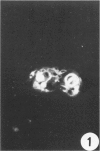Abstract
Thymic epithelial cells (TECs), which are known to influence T-cell differentiation, may undergo phenotypic changes and lose some differentiation antigens (for example, the HLA-DR complex) in neoplastic conditions and when they are grown in culture. Using an indirect immunofluorescence assay, the authors investigated the expression of the carcinoembryonic antigen (CEA) by normal cultured or pathologic human TECs. This antigen, which can be regarded as a marker of undifferentiation, disappears during the normal development of epithelial tissues and reappears in neoplastic conditions. In normal as well as hyperplastic (myasthenia gravis-associated) thymuses, the epithelial network (revealed in double-labeling experiments by an anti-keratin monoclonal antibody) is virtually CEA-negative, except for the specific labeling observed on some cells of Hassall's corpuscles. In thymomatous epithelial cells, however, a strong and specific fluorescent labeling was consistently detected in all thymomas studied. Thymic epithelial cells grown in cultures from fragments of normal thymuses also expressed CEA on their cell membranes. Interestingly, the relative number of CEA-positive cells increased as a function of the age of the primary culture and reached virtually 100% when monolayers became confluent (Days 12-14). Moreover, using an ELISA assay, the authors demonstrated the presence of CEA in supernatants from TEC cultures. Interestingly, the amount of CEA in these supernatants decreased as a function of the age of the culture. In addition, a marked inhibition of TEC proliferation was observed after treating the cultures with an anti-CEA serum. Our results demonstrate that CEA is expressed not only in situ by differentiated neoplastic TECs but also by normal TECs cultured in vitro. In addition, the inhibitory action of the anti-CEA serum on TEC proliferation suggests that CEA may act physiologically as a growth factor for proliferating epithelial cells. In this respect, cultures of human TECs represent a good model for further studies.
Full text
PDF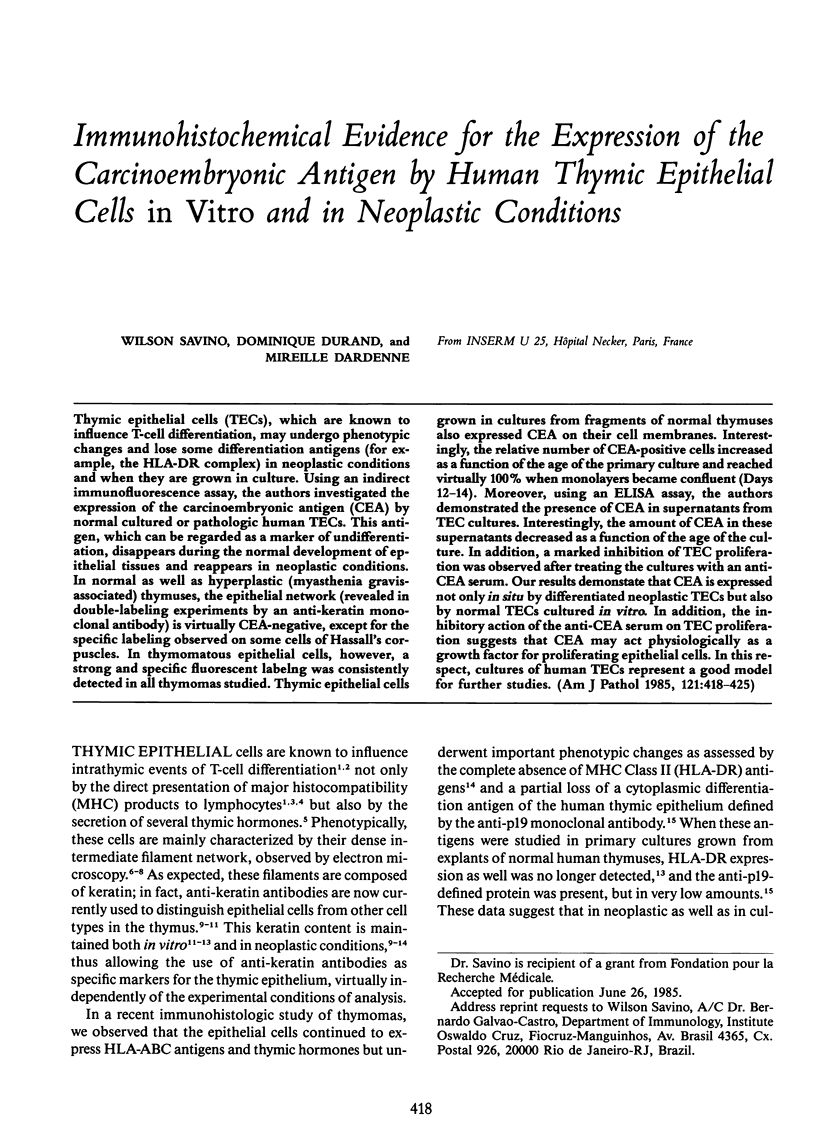
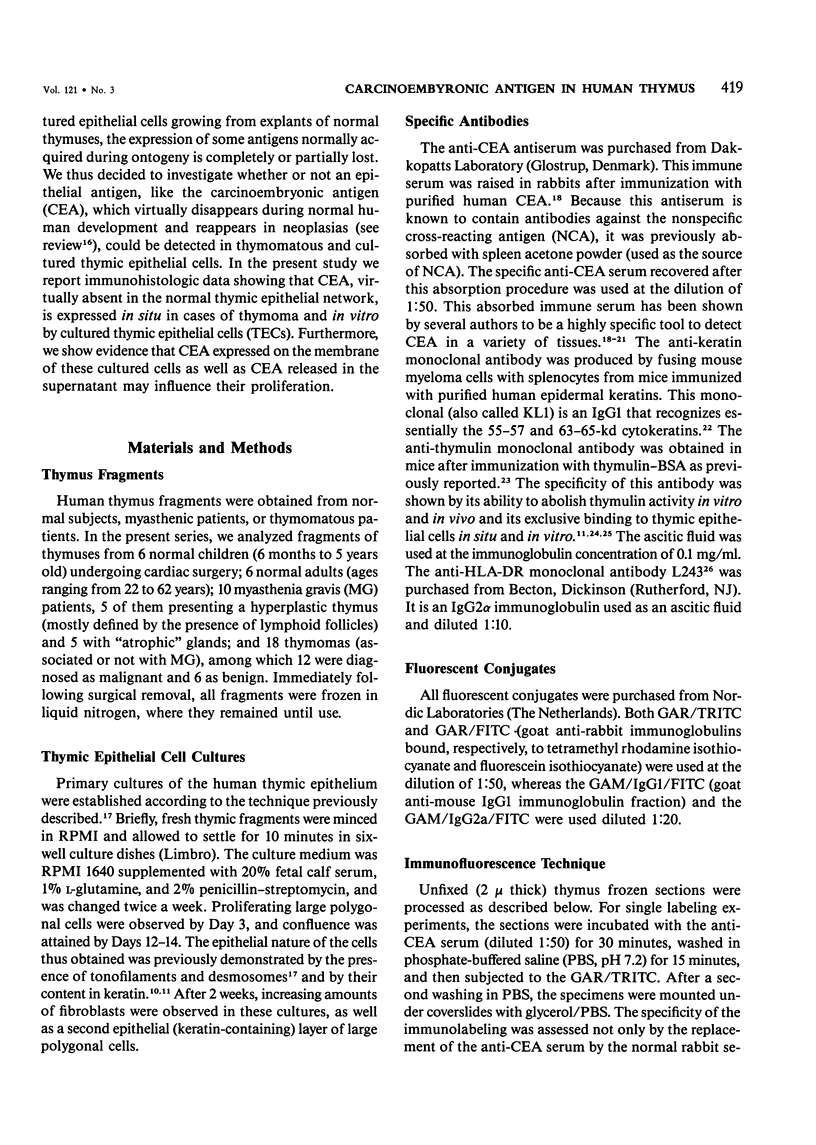
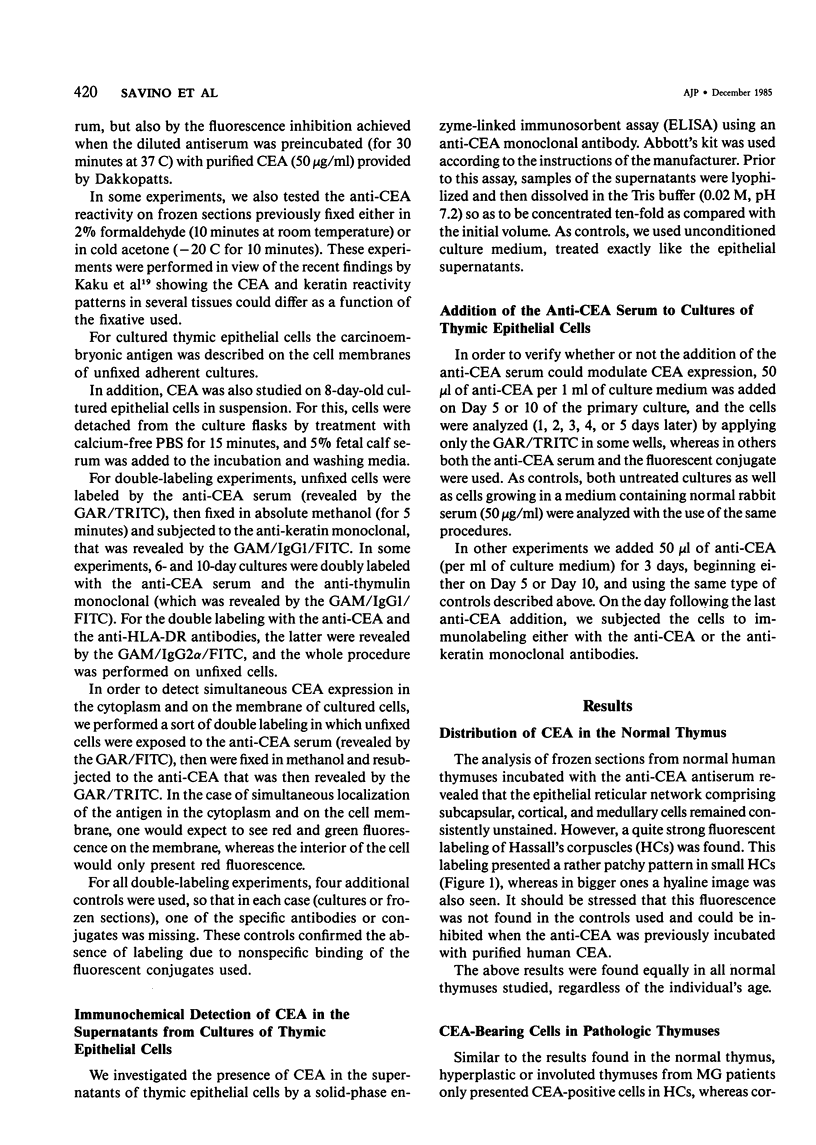



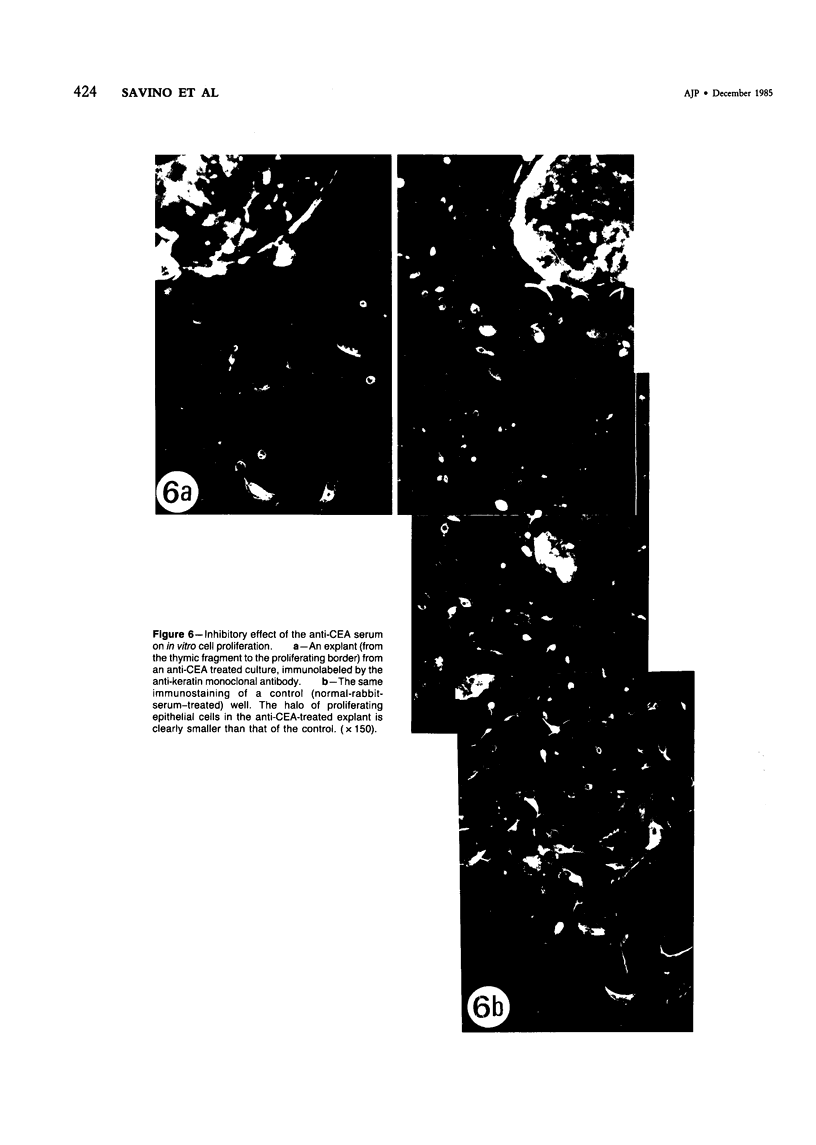

Images in this article
Selected References
These references are in PubMed. This may not be the complete list of references from this article.
- Auger C., Monier J. C., Dardenne M., Pleau J. M., Bach J. F. Identification of FTS (facteur thymique serique) on thymus ultrathin sections using monoclonal antibodies. Immunol Lett. 1982 Oct;5(4):213–216. doi: 10.1016/0165-2478(82)90137-7. [DOI] [PubMed] [Google Scholar]
- Battifora H., Sun T. T., Bahu R. M., Rao S. The use of antikeratin antiserum as a diagnostic tool: thymoma versus lymphoma. Hum Pathol. 1980 Nov;11(6):635–641. doi: 10.1016/s0046-8177(80)80074-8. [DOI] [PubMed] [Google Scholar]
- Bearman R. M., Levine G. D., Bensch K. G. The ultrastructure of the normal human thymus: a study of 36 cases. Anat Rec. 1978 Mar;190(3):755–781. doi: 10.1002/ar.1091900310. [DOI] [PubMed] [Google Scholar]
- Berrih S., Savino W., Azoulay M., Dardenne M., Bach J. F. Production of anti-thymulin (FTS) monoclonal antibodies by immunization against human thymic epithelial cells. J Histochem Cytochem. 1984 Apr;32(4):432–438. doi: 10.1177/32.4.6200531. [DOI] [PubMed] [Google Scholar]
- Bhan A. K., Reinherz E. L., Poppema S., McCluskey R. T., Schlossman S. F. Location of T cell and major histocompatibility complex antigens in the human thymus. J Exp Med. 1980 Oct 1;152(4):771–782. doi: 10.1084/jem.152.4.771. [DOI] [PMC free article] [PubMed] [Google Scholar]
- Breborowitz J., Easty G. C., Neville A. M. Letter: In-vitro production of carcinoembryonic antigen by normal and neoplastic colon. Lancet. 1973 Dec 15;2(7842):1393–1393. doi: 10.1016/s0140-6736(73)93366-7. [DOI] [PubMed] [Google Scholar]
- Cohen S., Berrih S., Dardenne M., Bach J. F. Régulation in vitro de la sécrétion de thymuline (FTS) par les cellules épithéliales thymiques humaines. C R Seances Acad Sci III. 1983;297(2):63–65. [PubMed] [Google Scholar]
- Dardenne M., Pleau J. M., Savino W., Bach J. F. Monoclonal antibody against the serum thymic factor (FTS). Immunol Lett. 1982 Feb;4(2):79–83. doi: 10.1016/0165-2478(82)90003-7. [DOI] [PubMed] [Google Scholar]
- Gold P., Shuster J., Freedman S. O. Carcinoembryonic antigen (CEA) in clinical medicine: historical perspectives, pitfalls and projections. Cancer. 1978 Sep;42(3 Suppl):1399–1405. doi: 10.1002/1097-0142(197809)42:3+<1399::aid-cncr2820420803>3.0.co;2-p. [DOI] [PubMed] [Google Scholar]
- Haynes B. F., Robert-Guroff M., Metzgar R. S., Franchini G., Kalyanaraman V. S., Palker T. J., Gallo R. C. Monoclonal antibody against human T cell leukemia virus p19 defines a human thymic epithelial antigen acquired during ontogeny. J Exp Med. 1983 Mar 1;157(3):907–920. doi: 10.1084/jem.157.3.907. [DOI] [PMC free article] [PubMed] [Google Scholar]
- Hwang W. S., Ho T. Y., Luk S. C., Simon G. T. Ultrastructure of the rat thymus. A transmission, scanning electron microscope, and morphometric study. Lab Invest. 1974 Nov;31(5):473–487. [PubMed] [Google Scholar]
- Kaku T., Ekem J. K., Lindayen C., Bailey D. J., Van Nostrand A. W., Farber E. Comparison of formalin- and acetone-fixation for immunohistochemical detection of carcinoembryonic antigen (CEA) and keratin. Am J Clin Pathol. 1983 Dec;80(6):806–815. doi: 10.1093/ajcp/80.6.806. [DOI] [PubMed] [Google Scholar]
- Lampson L. A., Levy R. Two populations of Ia-like molecules on a human B cell line. J Immunol. 1980 Jul;125(1):293–299. [PubMed] [Google Scholar]
- Lampson L. A., Levy R. Two populations of Ia-like molecules on a human B cell line. J Immunol. 1980 Jul;125(1):293–299. [PubMed] [Google Scholar]
- Nap M., Keuning H., Burtin P., Oosterhuis J. W., Fleuren G. CEA and NCA in benign and malignant breast tumors. Am J Clin Pathol. 1984 Nov;82(5):526–534. doi: 10.1093/ajcp/82.5.526. [DOI] [PubMed] [Google Scholar]
- Nap M., ten Hoor K. A., Fleuren G. J. Cross-reactivity with normal antigens in commercial anti-CEA sera, used for immunohistology. The need for tissue controls and absorptions. Am J Clin Pathol. 1983 Jan;79(1):25–31. doi: 10.1093/ajcp/79.1.25. [DOI] [PubMed] [Google Scholar]
- Natali P. G., Russo C., Ng A. K., Nicotra M. R., Apollonj C., Pellegrino M. A., Ferrone S. Ontogeny of human Ia antigens. Cell Immunol. 1982 Nov 1;73(2):385–396. doi: 10.1016/0008-8749(82)90465-8. [DOI] [PubMed] [Google Scholar]
- Rosenthal K. L., Tompkins W. A., Rawls W. E. Factors affecting the expression of carcinoembryonic antigen at the surface of cultured human colon carcinoma cells. Cancer Res. 1980 Dec;40(12):4744–4750. [PubMed] [Google Scholar]
- Rouse R. V., Weissman I. L. Microanatomy of the thymus: its relationship to T cell differentiation. Ciba Found Symp. 1981;84:161–177. doi: 10.1002/9780470720660.ch9. [DOI] [PubMed] [Google Scholar]
- Savino W., Berrih S., Dardenne M. Thymic epithelial antigen, acquired during ontogeny and defined by the anti-p19 monoclonal antibody, is lost in thymomas. Lab Invest. 1984 Sep;51(3):292–296. [PubMed] [Google Scholar]
- Savino W., Dardenne M., Papiernik M., Bach J. F. Thymic hormone-containing cells. Characterization and localization of serum thymic factor in young mouse thymus studied by monoclonal antibodies. J Exp Med. 1982 Aug 1;156(2):628–633. doi: 10.1084/jem.156.2.628. [DOI] [PMC free article] [PubMed] [Google Scholar]
- Schmitt D., Monier J. C., Dardenne M., Pleau J. M., Deschaux P., Bach J. F. Cytoplasmic localization of FTS (facteur thymique sérique) in thymic epithelial cells. An immunoelectronmicroscopical study. Thymus. 1980 Dec;2(3):177–186. [PubMed] [Google Scholar]
- Stutman O., Yunis E. J., Good R. A. Studies on thymus function. I. Cooperative effect of thymic function and lymphohemopoietic cells in restoration of neonatally thymectomized mice. J Exp Med. 1970 Sep 1;132(3):583–600. doi: 10.1084/jem.132.3.583. [DOI] [PMC free article] [PubMed] [Google Scholar]
- Sun T. T., Bonitz P., Burns W. H. Cell culture of mammalian thymic epithelial cells: growth, structural, and antigenic properties. Cell Immunol. 1984 Jan;83(1):1–13. doi: 10.1016/0008-8749(84)90219-3. [DOI] [PubMed] [Google Scholar]
- Viac J., Reano A., Brochier J., Staquet M. J., Thivolet J. Reactivity pattern of a monoclonal antikeratin antibody (KL1). J Invest Dermatol. 1983 Oct;81(4):351–354. doi: 10.1111/1523-1747.ep12519941. [DOI] [PubMed] [Google Scholar]
- Walker R. A. Demonstration of carcinoembryonic antigen in human breast carcinomas by the immunoperoxidase technique. J Clin Pathol. 1980 Apr;33(4):356–360. doi: 10.1136/jcp.33.4.356. [DOI] [PMC free article] [PubMed] [Google Scholar]
- van Haelst U. Light and electron microscopic study of the normal and pathological thymus of the rat. I. The normal thymus. Z Zellforsch Mikrosk Anat. 1967;77(4):534–553. doi: 10.1007/BF00319347. [DOI] [PubMed] [Google Scholar]



